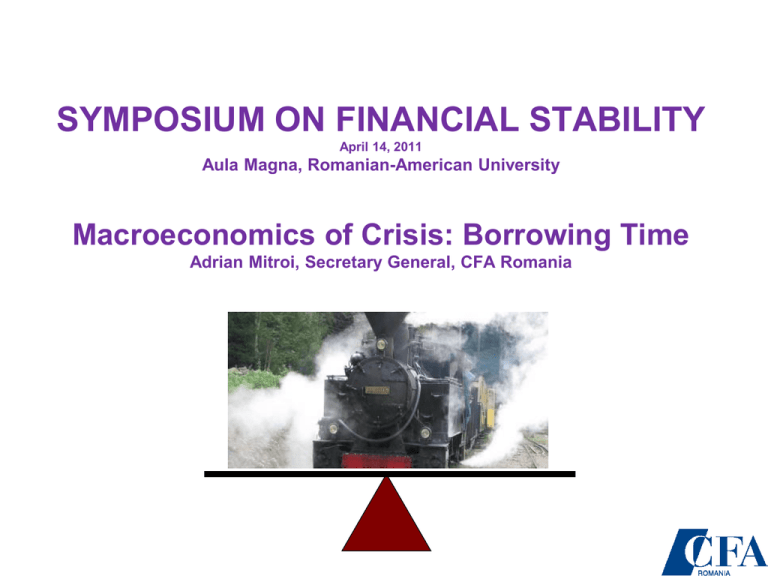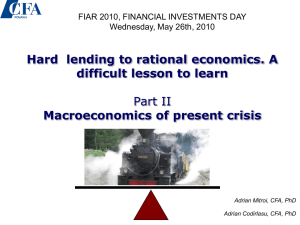Adi Mitroi presentation Conference on Financial Stability April 2011
advertisement

SYMPOSIUM ON FINANCIAL STABILITY April 14, 2011 Aula Magna, Romanian-American University Macroeconomics of Crisis: Borrowing Time Adrian Mitroi, Secretary General, CFA Romania unusual uncertain times? Macroeconomics of Crisis Buying time Decreased •Correlation: stocks, growth, inflation, deficits, exchange and interest rates correlation •Cyclical vs. countercyclical; conventional vs. non conventional policies •Financial sector, a pro cyclical indicator of real economy •Lending to negative equity; solvability vs. liquidity •Real estate market; LT real assets vs. ST financial liabilities A PsiFinance Perspective into the New Normal Economics Borrowing time Change in •Propensity to spend, save or invest in highly volatile markets paradigm •Risk aversion vs. loss aversion in economic recession •Decrease in bear markets correlation; only local black swans •Net wealth effect can be substituted for net income effect •Ultralow/easy money leads always to bubbles SYMPOSIUM ON FINANCIAL STABILITY, April 2011, Romanian-American University 2 Macro policies and markets Learning by doing Conventional •Cyclical: pro cyclical, correlated with overall state of the economy; ex. tightening monetary policy in recession (hawkish); higher than equilibriumappropriate exchange rate, fiscal tightening (VAT increase) •Conventional: monetary rate, (ex. strong Ron = tightening but decreased MRR = softening), open market; higher bound for repo interest = dovish •Countercyclical: activist (vs. laissez faire), against current economic tendency, lower monetary rate (dovish), simulative in economic downturn; ex: progressive tax, unemployment Terra Incognita in Macroeconomics Trial and error Ron Non conventional: easing cost and availability of funds; fiscal monetization: appreciation limited effect on •aimed at reduced risk spreads, affecting longer term rate across the board, independently of their liquidity and credit risk, affecting the market for risk inflation free assets, government bonds (QE- ‘quantitative easing’); BCE repos Unchartered •targeted on the risk spread across assets classes, between those whose territory markets are particularly impaired (PIGs junks as collateral) and those that are more functioning (CE- ‘credit easing’); EU/IMF/EC Stability Fund SYMPOSIUM ON FINANCIAL STABILITY, April 2011, Romanian-American University 3 One size monetary without fiscal policy Combination of reasons Not sure working •Common to all major crises, is a combination of reasons: overleverage, real estate boom, loose fiscal and monetary policies, overspending - debt difficult decisions: higher tax or lower spending/expenses? •ECB: one size fits all monetary policy has drawbacks, mostly in a downturn economy. Front runners (G) in recovery would rather enjoy an % increase once the growth picks up, but laggards (P, S) would rather see very low % for a longer term From 2 big to fail to 2 big to bail Bail outs equals bail ins Probably working •Moral hazard introduced by EU/IMF/EC stand by PIGs bailout was a necessary evil (write off). Probably, restructuring would have been better, but EU is not yet prepared to accept, manage, convince; China capitalizes Spanish Banks •Europe’s financial tribulations reflect investors concern that governments have borrowed too much to revive their economies; how do US manage? •No matter how smart and big is the bailout (EU Stabilization Fund), most important stakeholders have to buy in: population (to sacrifice) and private investors (to roll over next debt, at reasonable prices) SYMPOSIUM ON FINANCIAL STABILITY, April 2011, Romanian-American University 4 Conventional vs. nonconventional policies Debt transportation Which one is better? •Too much debt is dangerous. During boom, central banks, investment bankers and politicians all signed up to the cult of debt; SE Asia is the least levered, best prepared for sustained economic growth (financial and commercial) •Companies went for balance-sheet "efficiency" - and homeowners, piled on huge mortgages, were caught out, then discover that it is much harder to deleverage than to leverage up; basically, only rented home from the bank •When the Fed stops buying Treasuries, does the private sector take the baton and run the last leg of the relay race? New Normal Global Economics Change in paradigm Crisis or recession? •Globalization doesn't work smoothly by itself. Free movement of capital has facilitated rapid shifts in cross-border capital flows, currency values and prices of commodities; insufficient financial depth (savings and investments/GDP) makes a country vulnerable; first: save; then: invest; only then: spend •Most probable we all, insufficiently saved, inadequately invested and irrationally spent future cash flows (governments, corporations, individuals) SYMPOSIUM ON FINANCIAL STABILITY, April 2011, Romanian-American University 5 Central Banks matter Armada of measures, inflated BS Decreased •During a normal recession, the Fed, ECB and other central banks correlation responded with non conventional monetary policies by buying short-term government/quality (except for PIGs junks) debt from banks •Process drives rates on government debt down; investors seeking a higher rate move into other assets, driving other rates down; normally these lower rates will lead to economic bounceback; in recession, fiscal also matters Interchangeable fiscal, monetary Borrowing time; how/when to exit? Change in •A lower bound to rates advocates higher government spending: when paradigm monetary policy is ineffective and private sector can’t be persuaded to spend or borrow more, the public sector must take its place in supporting the economy •Probably the fiscal stimulus is Keynesian answer to current economic situation and a good mix with monetary policy. New normal recession requires CBs to be less concerned on inflation? Milton Friedman for growth and John Maynard Keynes for recession? SYMPOSIUM ON FINANCIAL STABILITY, April 2011, Romanian-American University 6 Central banks do matter since monetary and fiscal policies look interchangeable, lately ECB (Apr. 2011): •Marginal lending facility: 1.75 % •Main refinancing operations: 1.25 % •Deposit facility: 0.5 % FED (Apr. 2011): •Discount rate (charged to banks, refinancing, psychological): 50 bp •Fed Funds (o/n, benchmark, target, main policy rate): 0-25 bp 12 10 8 6 FED ECB BNR 4 2 0 31/01/2007 31/01/2008 31/01/2009 31/01/2010 SYMPOSIUM ON FINANCIAL STABILITY, 31/01/2011 April 2011, Romanian-American University NBR (April. 2011): •Deposit facility: 2.25% •Policy rate: 6.25% •Lend facility: 10.25% •MRR FX: 20% 7 Hold rates, strengthen Ron, prop solvability Sovereign debt pressure 2nd generation of structural reforms no pain all gain solution •Actual rate probably lower with 100 -150 bp than neutral •6.25% vs.~7% current neutral (5% historical) - need to tighten (100 bp) but output gap is negative (-4%). M. Finance % rate < LT GDP g % •VAT added (1st and 2nd) round 2.5%-3% fiscal inflation •Permanent increase in the inflation risk premium •Economic contraction positive countercyclical effect (March poor 8%) SYMPOSIUM ON FINANCIAL STABILITY, April 2011, Romanian-American University 8 Old answers to new questions Monetary medication plus fiscal diet Systemic risk Decreased •A bubble in government bonds has been deflated but yields will rise, correlation inflation, oversupply. •Need to print money to pay interest on new debt; result: a slower recovery; growth is a key determinant for deficits •Add corporate and private debt to government debt / GDP, the prospect of economic growth paying all that off is moving further in time Sovereign debt pressure Public loss private gains Change in •Debt restructuring, could be the new currency devaluation in the euro paradigm zone if not proper measure taken; •Higher borrowing cost (LT) could lead to higher deficits; EU Stabilization Plan targets MT/LT rates •Creditors are also massive debtors. If the value of their assets declines, the only way they can stay solvent is by reducing their debt, sell assets, pushes price down further, exacerbating and spreading it to other securities/currency (€) SYMPOSIUM ON FINANCIAL STABILITY, April 2011, Romanian-American University 9 Real vs. financial/virtual economy Wealth effect vs. income effect Commercial •Governments have borrowed too much to revive economies, causing (2011) volatility, pushing the limits of fiscal and monetary stimulation; vs. financial prosperity, however, takes time Financial •Banking and financial sector, a lagging, pro cyclical indicator of real economy; although economy hoped to clearly rebound in 2011, GDP growth is not enough •Banks will not give loans on concerns of negative equity; pro cyclical attitude: the more credit you need, less able you are. Unemployment is a key indicator The weak Dollar syndrome Easy FED takes $ from savers Bernanke's floor and put $ 15% yoy •Post real estate boom market: real assets vs. financial liabilities decrease - big stability: bail out countries (PIGs) is to keep financing loss for China •Financial banks sovereign exposure solvable; money-printing is just another way for governments to silently default on their debt •ChIndia, probably best market capitalists have socialist ideology and US will not make it easier for EU; EU does not make it easier for EU SYMPOSIUM ON FINANCIAL STABILITY, April 2011, Romanian-American University 10 Liquidity Bail out Decreased •Liquidity (ST, EU Stabilization Fund) and solvency (LT, deficits) are not correlation inter changeable. Interest rate risk vs. credit/counterparty risk •Liquidity provided by CBs can make a difference on ST but not on a LT; markets are becoming completely dependent on Central Banks. Dark side of Euro: one size fits all could be suboptimal in times of crisis •Negative equity: market value of assets < present value of liabilities. Deleveraging is a must (7/91 stressed European Banks w/ Tier1 < 6%) Solvency Bail in Change in •Solvability (LT, renewable ability to borrow) vs. liquidity (short term) •High debt/GDP, high deficit/GDP, low growth – LT endangered species paradigm •An absolute economic pecking order: 1: recovery 2: growth 3: expansion 4: prosperity •What if Oil does not decrease till Q4? What when FED stops buying? •Bail out: €B 865 (EFSF: 440, IMF: 280/US 50, EFSM: 60, Bilateral: 85) SYMPOSIUM ON FINANCIAL STABILITY, April 2011, Romanian-American University 11 SYMPOSIUM ON FINANCIAL STABILITY, April 2011, Romanian-American University 12 Carry trade the easy money Ultralow monetary for net wealth Decreased •Then (2009): reverse correlation; when the dollar would fall, stocks correlation would rise and vice versa; euro was strong, EM currencies, including Ron, were under pressure •Why: CT investors were using a currency that cost almost nothing to borrow ($,¥) to buy undervalued stocks, with a bias toward emerging markets; combination lift stocks off their 2009 March lows Currencies and stocks Competitive re(de)valuation Change in •Now (2011): stocks and the dollar are moving up in tandem again, but paradigm not down (weak Euro from B/Outs?); a signal for investors to put more money into $ denominated assets? a signal to sell Euro denominated assets and buy into emerging markets (Ron?) •Countercyclical Dollar and Yen are now less favorite CT currencies, due to strengthening and overall volatility; with $, ¥, and volatility up SYMPOSIUM ON FINANCIAL STABILITY, April 2011, Romanian-American University 13 Dollar Cyclical tailwind Decreased •Typical paradigm for an export oriented Europe was that a strong dollar / weak euro is good for trade, for both US and China. A weakening euro correlation (a political not economic currency) is of benefit to PIIGS, alleviating some excessive deficits and making their products more competitive •Raw materials, mostly denominated in dollars are making inputs prices more expensive adding additional strain on expected growth differential vs. US. This will lead probably to an earlier interest rate hike, make now dollar assets attractive; now: strong CHF, J¥, €; undervalued C¥ Euro Structural headwind Cyclical or •During the toughest part of recession, the dolar weakend against most of other currencies. A depreciating currency is a good antirecessonary countercyclical tool; a low $ exports recession and a strong $ imports growth •Banks are a lagging economic conditions. CBs, trying to protect currency stability and debtors, would rather sacrifice future, potential debtors/present depositors than curent debtors solvability position •Main risks to fiscal consolidation stem from too optimistic assumptions and lack of specification; if EU didn’t have common currency, it would have bigger problems or vice versa? SYMPOSIUM ON FINANCIAL STABILITY, April 2011, Romanian-American University 14 SYMPOSIUM ON FINANCIAL STABILITY, April 2011, Romanian-American University 15 Diversification along sectors, assets, managers Economy (2011-2012) Probability A (energy sector) B (financials sector) Boom 0.25. 20% 5% Normal 0.50 10% 10% Recession 0.25 0% 15% •Ra = (0.25) (0.20) + (0.50) (0.10) + (0.25) (0.00) = 0.10 •Rb = (0.25) (0.05) + (0.5) (0.10) + (0.25) (0.15) = 0.10 •Σ2a = (0.25) (0.20-0.10)2 + (0.5) (0.10-0.10)2 + (0.25) (0.00-0.10)2 = 0.005 •σ2b = (0.25)(0.05-0.10)2 + (0.5)(0.10-0.10)2 + (0.25)(0.15-0.10)2 = 0.00125 •σa = (0.005)1/2 = 0.07071 = 7.071% • σb = (0.00125)1/2 = 0.03536 = 3.536 % •Covab = (0.25)[(0.20-0.10)(0.05-0.10)]+ (0.50)[(0.10-0.10)]+ (0.25)[(0.00-0.10)(0.15-0.10)]= - 0.0025 •ρ(a,b) = cov (a,b) / σ2a σ2b = - 1 SYMPOSIUM ON FINANCIAL STABILITY, April 2011, Romanian-American University 16 Risk appetite increases at the wrong moment and for the wrong reason, just when risk capacity decreases; net wealth effect (market) compensates for net income effect (lower wage) SYMPOSIUM ON FINANCIAL STABILITY, April 2011, Romanian-American University 17 2011 Portfolio diversification: 50% stocks + 50% bonds Probability Equity fund % Bond fund % 50% equity + 50 % bond Recession 1/3 -7 17 +5 Normal 1/3 + 12 +7 + 9.5 Boom 1/3 + 28 -3 +12.5 Expected return 11 7 9 Variance 204.7 66.7 9.5 Standard deviation 14.3 8.2 3.1 •Cov(s,b) •ρ(s,b) = 0,3333(-7-11)(17-7)+0.3333(12-11)(7-7)+0.3333(28-11)(-3-7) = -116.67 = cov (s,b) / σaσb= -116.66 / [(14.3) (8,2)] = - 0.99 SYMPOSIUM ON FINANCIAL STABILITY, April 2011, Romanian-American University 18 Emotional Phases; case study: PIGS Phase 1 Phase 2 Phase 3 Phase 4 Phase 5 Overall 1 ▪ Emotions and guts do matter 2 Survival of the able planner 3 ▪ ▪ ▪ ▪ ▪ Markets are not always rational ▪ ▪ 4 Confidence ▪ ▪ Individuals always act in their own best interest, economic Success and prosperity are strong anesthetics ▪ Biological rigor prevails History is written by winners Right decision feels, right, investor sentiment ▪ Unstable balance between fear and greed People have noneconomic reasons and irrational behaviors ▪ Achievement begets success Success begets confidence Confidence begets opportunities Individuals make mistakes Pain is a strong evolutionary trick that quads us against dangers ▪ ▪ ▪ ▪ ▪ ▪ Behavioral biases create bubble and bust phases that are hard to predict Contrarian strategy needs steadfastness Both markets and investors evolve and adapt Frame dependence Mental accounting Risk is rewarded, in general, by higher return, but not necessarily Risk is seriously punished during crises, rational or not ▪ ▪ ▪ ▪ ▪ ▪ ▪ ▪ ▪ ▪ ▪ Individual learn, adapt (heuristic) but make a lot of mistake in the process Residual risk aversion Overconfidence ▪ Even best strategies wax and wane over time If the market is efficient, what is the use of stock picking ability? ▪ Financial education is a necessity; manage assets and liabilities Think long term Make sacrifices Can do attitude ▪ Progress in finance is cyclical Economic creativity is key to human development ▪ SYMPOSIUM ON FINANCIAL STABILITY, ▪ ▪ ▪ ▪ Individuals act feasibly, and always try to satisfice People consumed to much and invested too little ▪ ▪ A 95% perfect strategy is a non performing strategy Do the right thing only after had exhausted every other alternative ▪ Greed makes crisises unavoidable; humans are kind, generous, Econs are unscrupulous, have a limited span of interest and attention ▪ Inertia is a very powerful force Most of the decisions we make in our lives is based on our level of confidence April 2011, Romanian-American University ▪ ▪ ▪ ▪ ▪ Competition imposes continuous adaptation Adaptation, flexibility, innovation and compromise are key to survival Survival is all that matters Pain is temporary, quitting is permanent Regret aversion Pace of change in business is faster than ever Representativeness Save more tomorrow People do not react well to bans or mandates; they react best at nudging 19 Too big to fail but fit enough to carry trade the easy money Paper out the crisis to the future SYMPOSIUM ON FINANCIAL STABILITY, April 2011, Romanian-American University 20 What if: 1% (end of 2011, ECB) increase in short-term rates Expected Balance Sheet for Hypothetical Bank Assets Yield Liabilities Cost Rate sensitive $ 500 9.0% $ 600 5.0% Fixed rate $ 350 11.0% $ 220 6.0% Non earning $ 150 $ 100 $ 920 Equity $ 80 Total $ 1,000 $ 1,000 NII = (0.09 x 500 + 0.11 x 350) - (0.05 x 600 + 0.06 x 220) NII = 83.5 - 43.2 = 40.3 NIM = 40.3 / 850 = 4.74% GAP = 500 - 600 = -100 With a negative GAP, more liabilities than assets reprice higher; hence NII and NIM fall ECB tightening will pressure banks, lending, growth SYMPOSIUM ON FINANCIAL STABILITY, April 2011, Romanian-American University 21 Adjust Rate Sensitivity of a Bank’s Assets and Liabilities (core EU: more fixed rates vs. periphery EU: more variable rates) Objective Approaches (core vs. periphery Europe) Reduce asset sensitivity • • • Buy longer-term securities Lengthen the maturities of loans Move from floating-rate loans to term loans Increase asset sensitivity • • • Buy short-term securities Shorten loan maturities Make more loans on a floating-rate basis • • Pay premiums to attract longer-term deposit Issue long-term subordinated debt • • Pay premiums to attract short-term deposit Borrow more via non-core purchased liabilities Reduce liability sensitivity Increase liability sensitivity SYMPOSIUM ON FINANCIAL STABILITY, April 2011, Romanian-American University 22 Oil vs. Euro; higher Euro or lower Dollar? SYMPOSIUM ON FINANCIAL STABILITY, April 2011, Romanian-American University 23 Gold vs. Euro; higher Euro or lower Dollar? EU: prosperity by austerity US: assumption and consumption SYMPOSIUM ON FINANCIAL STABILITY, April 2011, Romanian-American University 24 DJIA vs. BET; Dollar weakening (15%) - no procyclical decorrelation SYMPOSIUM ON FINANCIAL STABILITY, April 2011, Romanian-American University 25 The Black Eyrar Yield curve bet vs. credit quality bet Global insolvency of current benefits; need to transfer/lower standard of living Portfolio managers time level of interest rates relative to cycle, adjust maturities: • A pension that has to pay €10,000 in 50 years (@4 %) in today’s money, €1,400; use of 7 % reduces that to €340 today, but €10,000 remains • IFRS: “discount rate should reference to market yields on high quality corporate bonds with similar durations to those of benefit obligations” • Where a deep market of corporate bonds do not exist (CEE), pension companies discount at yield on TBs • time interest rate peaks, counter-cyclical strategy: the changes in loan demand and the yield curve’s shape Mrs. Market infinite energy to prove us wrong • Solvability and liquidity are not interchangeable • Cannot transform liquidly into solvability except by sale at loss (S = L - Current Loss) • at top of cycle, expanding portfolio, when interest rates and loan demand are high lengthening maturities • An investor/debtor (The Real Estate Inc.) can’t get rich by buying an overvalued asset except by miracle or luck; luck is non recurrent • yield curve generally inverts when rates are at peak prior to recession • Deficit of competitiveness and Black Eyrar: • at bottom interest rates and loan demand are low, bank contracts portfolio, shortens maturities SYMPOSIUM ON FINANCIAL STABILITY, April 2011, Romanian-American University 26 The same old sun: easy to be smart on hindsight Over optimism is a basic tenet of human species In general, people do not spend time looking and understanding bad news Investors would rather prefer to focus on the bright side of the moon and they do not see things that they do not expect to see In the war b/w upper and lower class, it is the middle class that pays the price Where are we now? SYMPOSIUM ON FINANCIAL STABILITY, April 2011, Romanian-American University 27





